Analysis of Electric Breakup Characteristics of Emulsion Droplets Based on Dissipative Particle Dynamics Method
Abstract
:1. Introduction
2. Mathematical Model
2.1. Dissipative Particle Dynamics Method
Dissipative Particle Dynamics Theory
2.2. Numerical Integration Method
2.3. Boundary Conditions and Initial Conditions
3. Simulation Condition
3.1. Physical Model and Validity Verification
3.2. Boundary Conditions and Simulation Settings
4. Results and Discussion
4.1. The Deformation and Fragmentation Process of the Emulsion Droplet
4.2. The Modification of the Agglomeration Kernel Function
4.3. Determination of Critical Electric Field Strength
5. Conclusions
- (1)
- The breaking process of emulsion droplets under the action of an electric field is divided into three stages: firstly, polarized charges are generated on the surface of the emulsion droplets and the emulsion droplets are stretched and deformed under the action of an electric field; secondly, during the stretching and deformation stage, as the particles inside the droplet move, the density of the droplet portion decreases, resulting in a particular area of depression; finally, the concave position is squeezed by conservative force to break the emulsion droplets.
- (2)
- The physical properties of oil and water, the electric field, and the size of the emulsion droplets significantly affect the breaking time of emulsion droplets. For example, as the conservative force parameter and the random force intensity increase, the breaking of emulsion droplets first speeds up and then slows down; the breaking time decreases with the increase in the relative permittivity of the oil phase and the amplitude and frequency of the electric field; as the droplet size increases, the breaking time also increases.
- (3)
- The critical electric field strength of the emulsion droplets was calculated. The results show that the critical electric field strength of the emulsion droplets and the size of the emulsion droplets were approximately minus one-half power, and due to the limitations of the DPD method and the simplified processing of the calculation process, specific corrections were made when fitting the numerical simulation results. The fitting relationship is as in Equation (20).
Author Contributions
Funding
Data Availability Statement
Conflicts of Interest
References
- Bailes, P.J. An experimental investigation into the use of high voltage DC fields for liquid phase separation. Trans. Inst. Chem. Eng. 1981, 59, 229–237. [Google Scholar]
- Alves, R.P.; Oliveira, R.C. Petrobras. How to establish a mathematical model for the electroststic desalting process based on pilot plant studies. In Proceedings of the the SPE Annual Technical Conference and Exhibition, San Antonio, TX, USA, 24–27 September 2006; pp. 1–5. [Google Scholar]
- Lu, G.; Lu, Q.H.; Li, P.S. Break-down of liquid membrane emulsion under high electric field. J. Membr. Sci. 1997, 128, 1–6. [Google Scholar]
- Tsuneki, I.; Keisuke, I.; Shigeki, Y.; Masao, S. Rapid demulsification of dense oil-in-water emulsion by low external electric field I. Experimental evidence. Colloids Surf. A Physicochem. Eng. 2004, 242, 21–26. [Google Scholar]
- Taylor, S.E. Investigations into the electrical and coalescence behaviour of water-in-crude oil emulsions in high voltage gradients. Colloids Surf. 1988, 29, 29–51. [Google Scholar] [CrossRef]
- Yong, M.J.; Hyun, C.O. Electrical charging of a conducting water droplet in a dielectric fluid on the electrode surface. J. Colloid Interface Sci. 2008, 322, 617–623. [Google Scholar]
- Noik, C.; Chen, J.Q.; Dalmazzone, C. Electrostatic Demulsification on Crude Oil: A State-of-the-Art Review. In Proceedings of the the International Oil & Gas Conference and Exhibition in China, Beijing, China, 5–7 December 2006; pp. 1–12. [Google Scholar]
- John, S.E.; Mojtaba, G. Electrostatic enhancement of coalescence of water droplets in oil: A review of the current understanding. Chem. Eng. J. 2001, 85, 173–192. [Google Scholar]
- Waterman, L.C. Electrical coalesces. Chem. Eng. Prog. 1965, 61, 51–57. [Google Scholar]
- Merv, F. Water-in-Oil Emulsion Formation: A Review of Physics and Mathematical Modelling. Spill Sci. Technol. Bull. 1995, 2, 55–59. [Google Scholar]
- Der, O.; Bertola, V. An experimental investigation of oil-water flow in a serpentine channel. Int. J. Multiph. Flow 2020, 129, 103327. [Google Scholar] [CrossRef]
- Sarkar, P.S.; Singh, K.K.; Shenoy, K.T.; Sinha, A.; Rao, H.; Ghosh, S.K. Liquid–Liquid Two-Phase Flow Patterns in a Serpentine Microchannel. Ind. Eng. Chem. Res. 2012, 51, 5056–5066. [Google Scholar] [CrossRef]
- Taylor, G. Studies in electrohydrodynamics. I. The circulation produced in a drop by an electric field. Proc. R. Soc. Lond. 1966, 291, 159–166. [Google Scholar]
- Torza, S.; Cox, R.G.; Mason, S.G. Electrohydrodynamic deformation and burst of liquid drops. Phil. Traps. R. Soc. Lond. 1971, 269, 295–319. [Google Scholar]
- Ajayi, O.O. A note on Taylor’s electrohydrodynamic theory. Proc Roy Soc. Lond. A 1978, 364, 499–507. [Google Scholar]
- Hua, L.; Lirn, L.K.; Wang, C.H. Numerical simulation of deformation/motion of a drop suspended in viscous liquids under influence of steady electric fields. Phys. Fluids 2008, 20, 113302. [Google Scholar] [CrossRef]
- Tomar, G.; Gerlach, D.; Biswas, G.; Alleborn, N.; Sharma, A.; Durst, F.; Welch, S.W.J.; Welch, A. Two-phase electrohydrodynamic simulations using a volume-of-fluid approach. Comput. Phys. 2007, 227, 1267–1285. [Google Scholar] [CrossRef]
- Sonic, P.; Juvekar, V.A.; Naik, V.M. Investigation on dynamics of double emulsion droplet in a uniform electric field. J. Electrost. 2013, 71, 471–477. [Google Scholar] [CrossRef]
- Eow, J.S.; Ghadiri, M. Drop-drop coalescence in an electric field: The effects of applied electric field and electrode geometry. Colloids Surfaces A Physicochem. Eng. 2003, 219, 253–279. [Google Scholar] [CrossRef]
- Eow, J.S.; Ghadiri, M.; Sharif, A. Experimental studies of deformation and break-up of aqueous drops in high electric fields. Colloids Surfaces A Physicochem. Eng. 2003, 225, 193–210. [Google Scholar] [CrossRef]
- Eow, J.S.; Ghadiri, M.; Sharif, A. Deformation and break-up of aqueous drops in dielectric liquids in high electric fields. J. Electrost. 2001, 51, 463–469. [Google Scholar] [CrossRef]
- Lac, E.; Homsy, G.M. Axisymmetric deformation and stability of a viscous drop in a steady electric field. J. Fluid Mech. 2007, 590, 239264. [Google Scholar] [CrossRef]
- Ha, J.; Yang, S. Effects of surfactant on the deformation and stability of a drop in a viscous fluid in an electric field. Colloid Interface Sci. 1995, 175, 369–385. [Google Scholar] [CrossRef]
- Ha, J.; Yang, S. Effect of nonionic surfactant on the deformation and breakup of a drop in an electric field. Colloid Interface Sci. 1998, 206, 195–204. [Google Scholar] [CrossRef] [PubMed]
- Hoogerbrugge, P.J.; Koelman, J.M.V.A. Simulating microscopic hydro-dynamic phenomena with dissipative particle dynamics. Euro Phys. Lett. 1992, 19, 155–160. [Google Scholar] [CrossRef]
- Espańol, P.; Warren, P. Statistical mechanics of dissipative particle dynamics. Lett. Euro Phys. 1995, 30, 191–196. [Google Scholar] [CrossRef]
- Groot, R.D.; Warren, P.B. Dissipative particle dynamics: Bridging the gap between atomistic and mesoscopic simulation. Chem. Phys. 1997, 107, 4423. [Google Scholar] [CrossRef]
- Liyana-Arachchi, T.P.; Jamadagni, S.N.; Eike, D.; Koenig, P.H.; Siepmann, J.I. Liquid-liquid equilibria for soft-repulsive particles: Improved equation of state and methodology for representing molecules of different sizes and chemistry in dissipative particle dynamics. Chem. Phys. 2015, 142, 044902. [Google Scholar] [CrossRef] [PubMed]
- Español, P.; Warren, P.B. Perspective: Dissipative particle dynamics. Chem. Phys. 2017, 146, 150901. [Google Scholar] [CrossRef] [PubMed]
- Revenga, M.; Zuniga, I.; Espanol, P. Boundary model in DPD. Int. J. Mod. Phys. C 1998, 9, 1319–1328. [Google Scholar] [CrossRef]
- Li, B.; Vivacqua, V.; Ghadiri, M.; Sun, Z.; Wang, Z.; Li, X. Droplet deformation under pulsatile electric fields. Chem. Eng. Res. Des. 2017, 127, 180–188. [Google Scholar] [CrossRef]
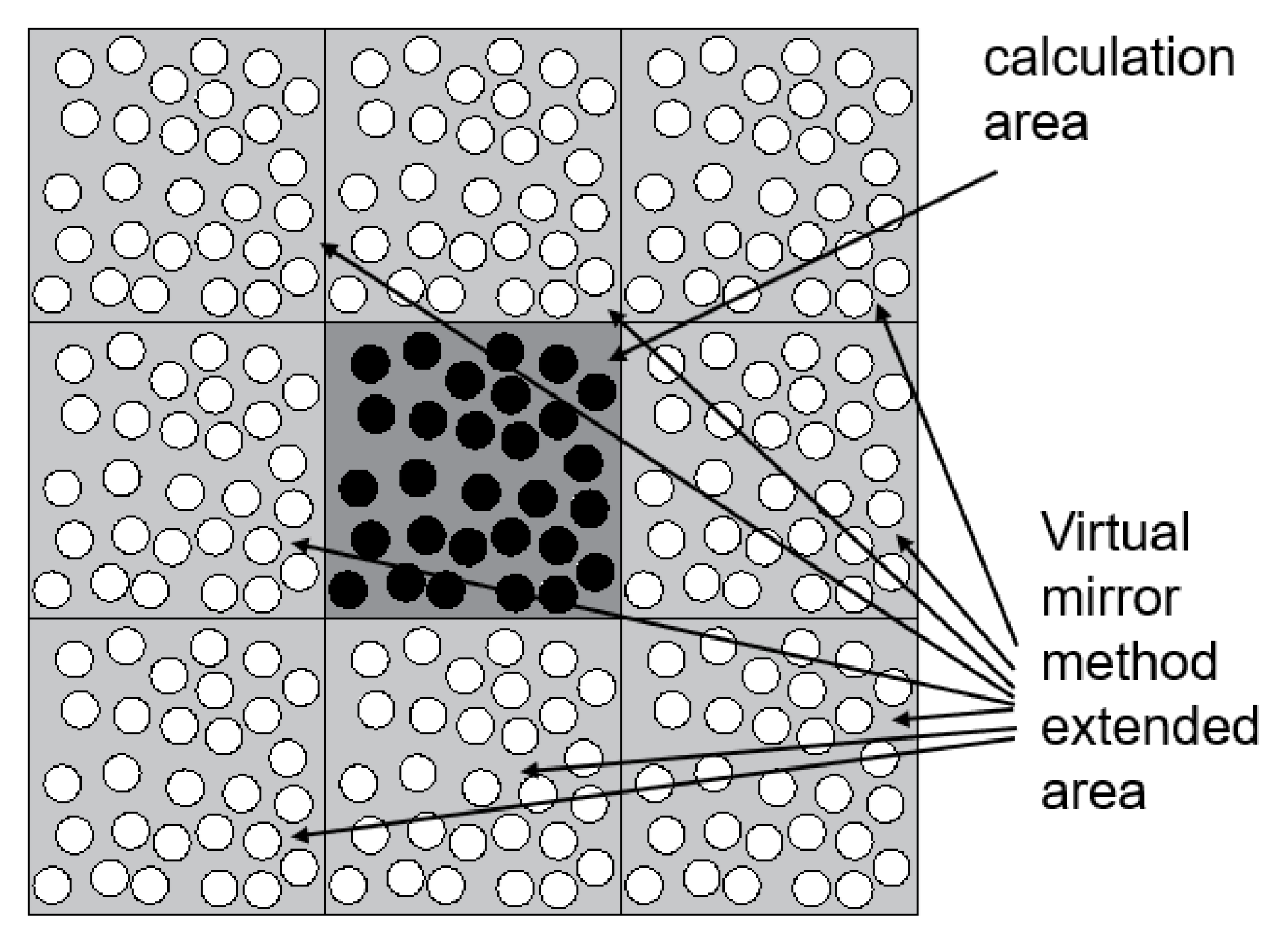
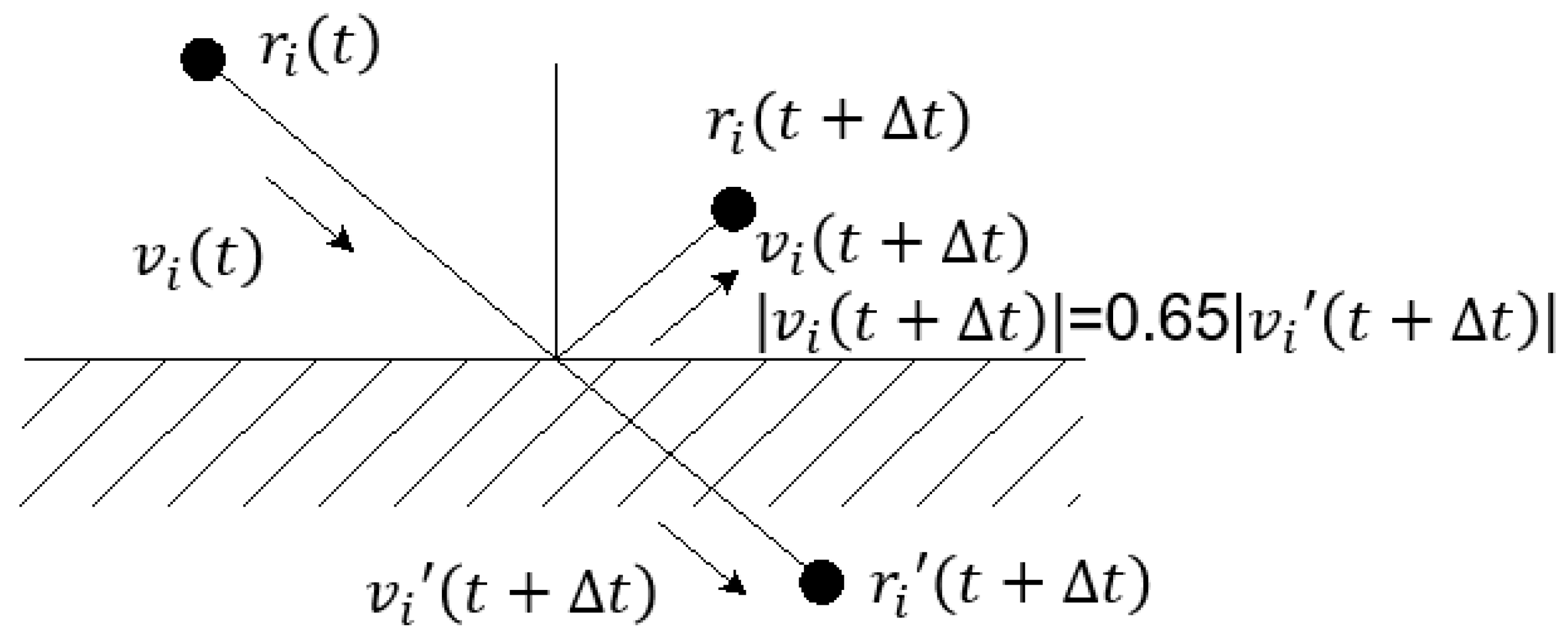
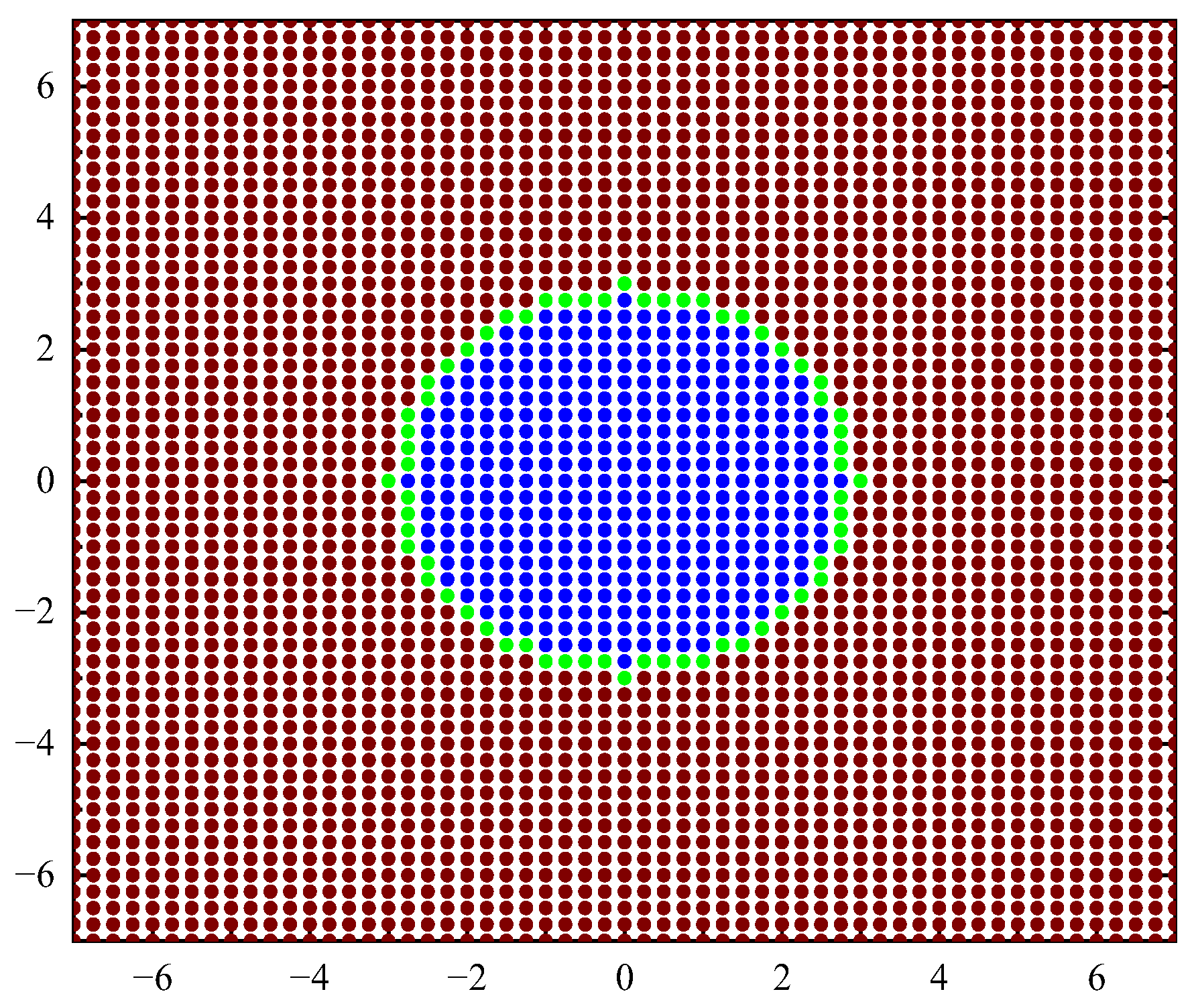
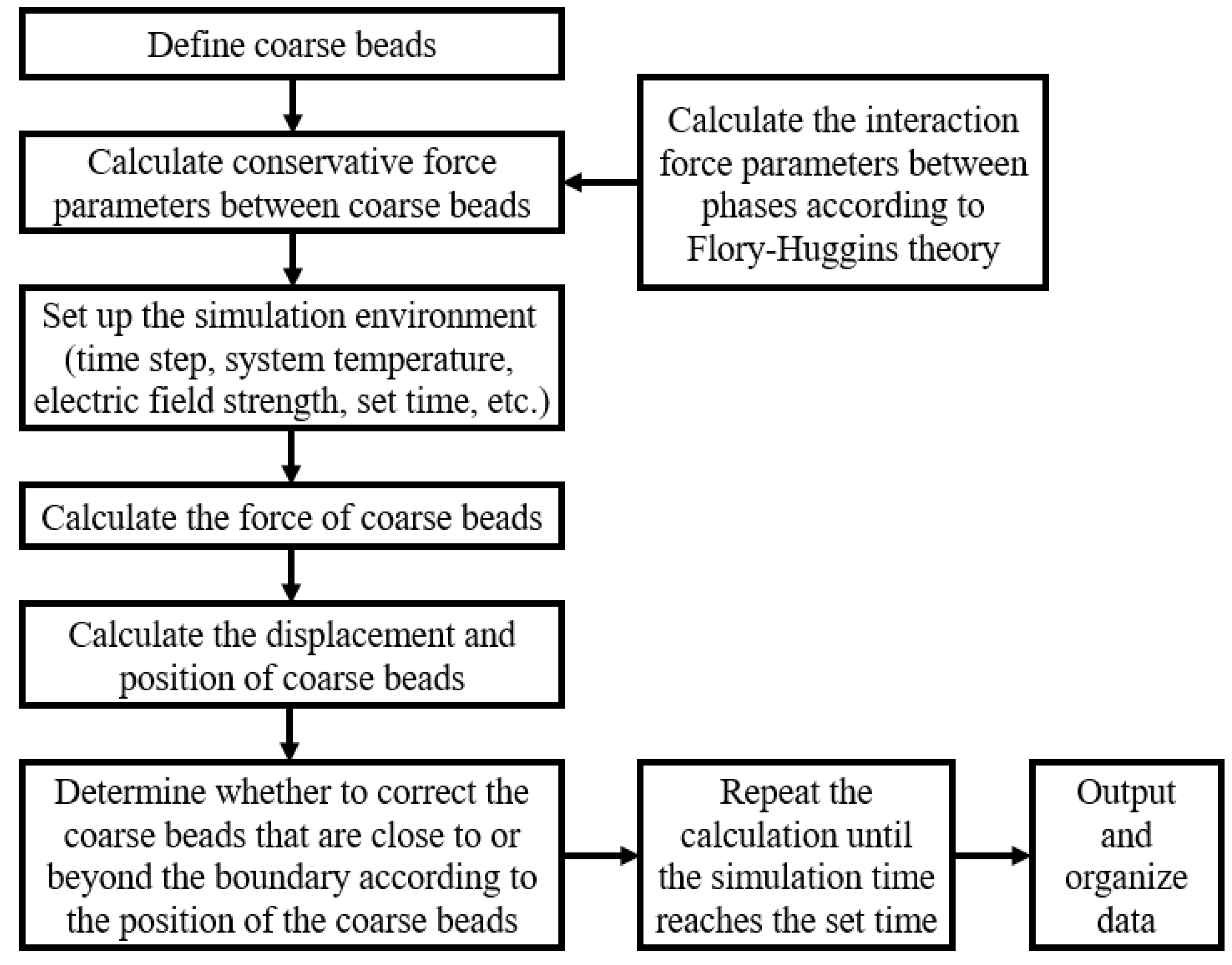

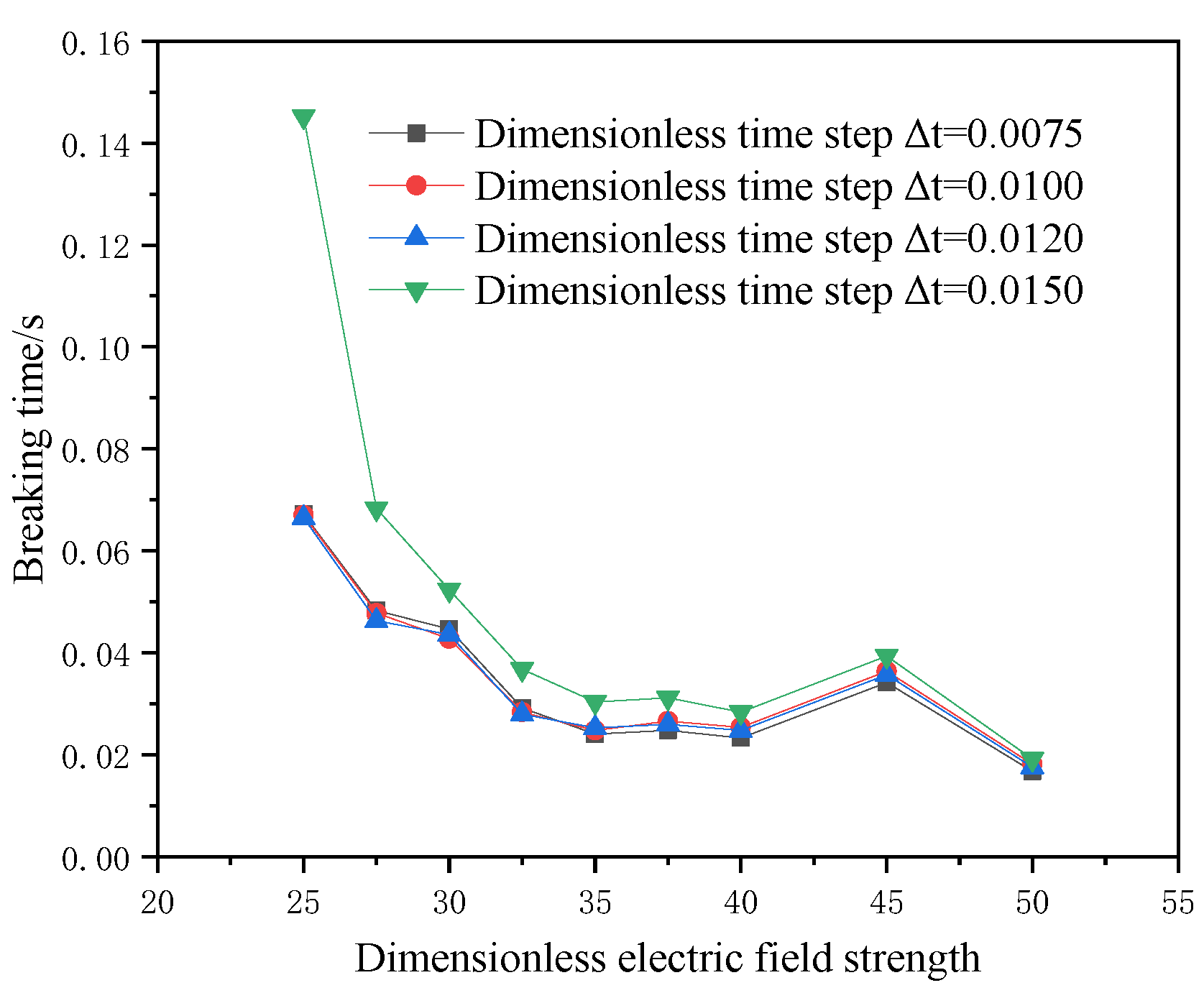

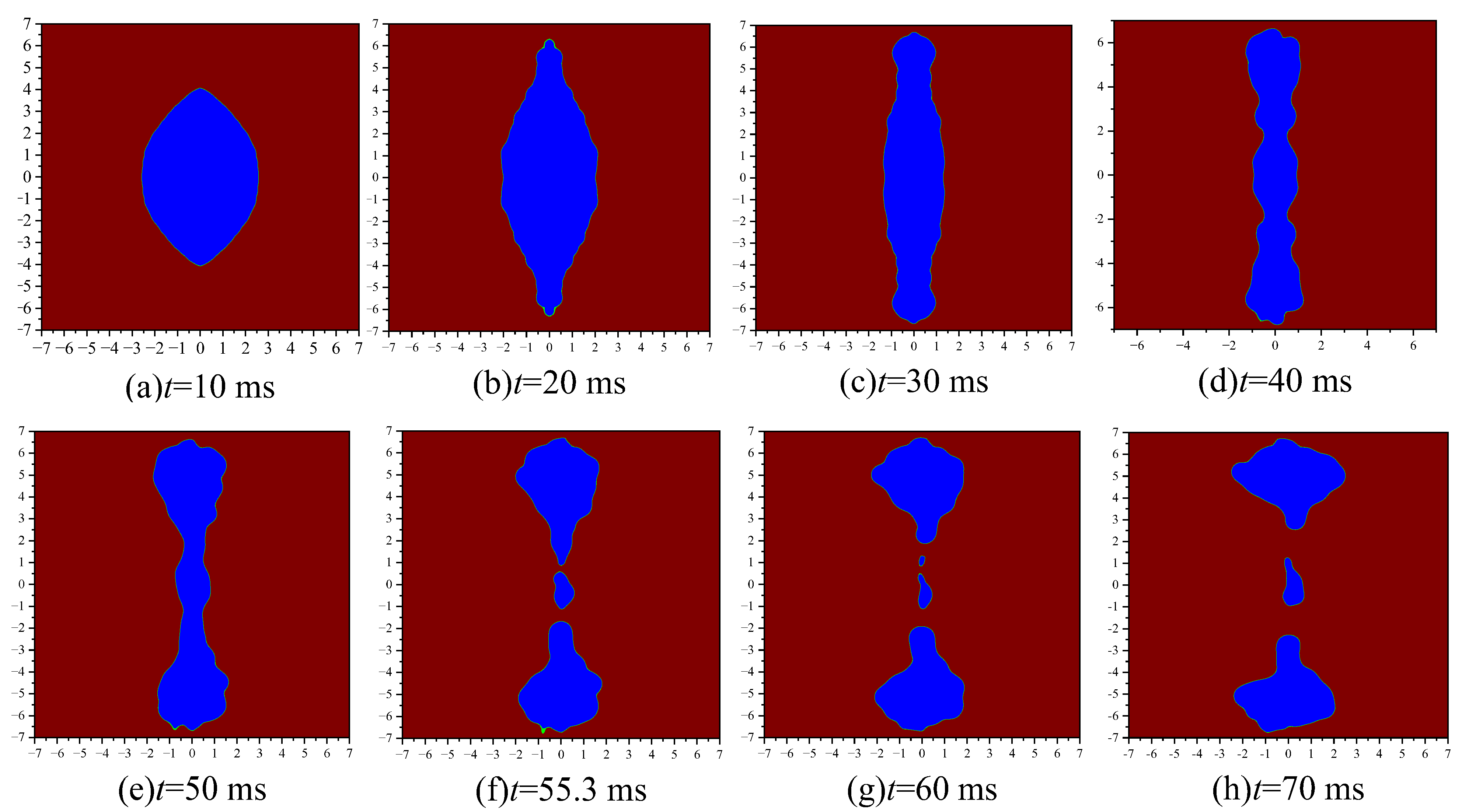
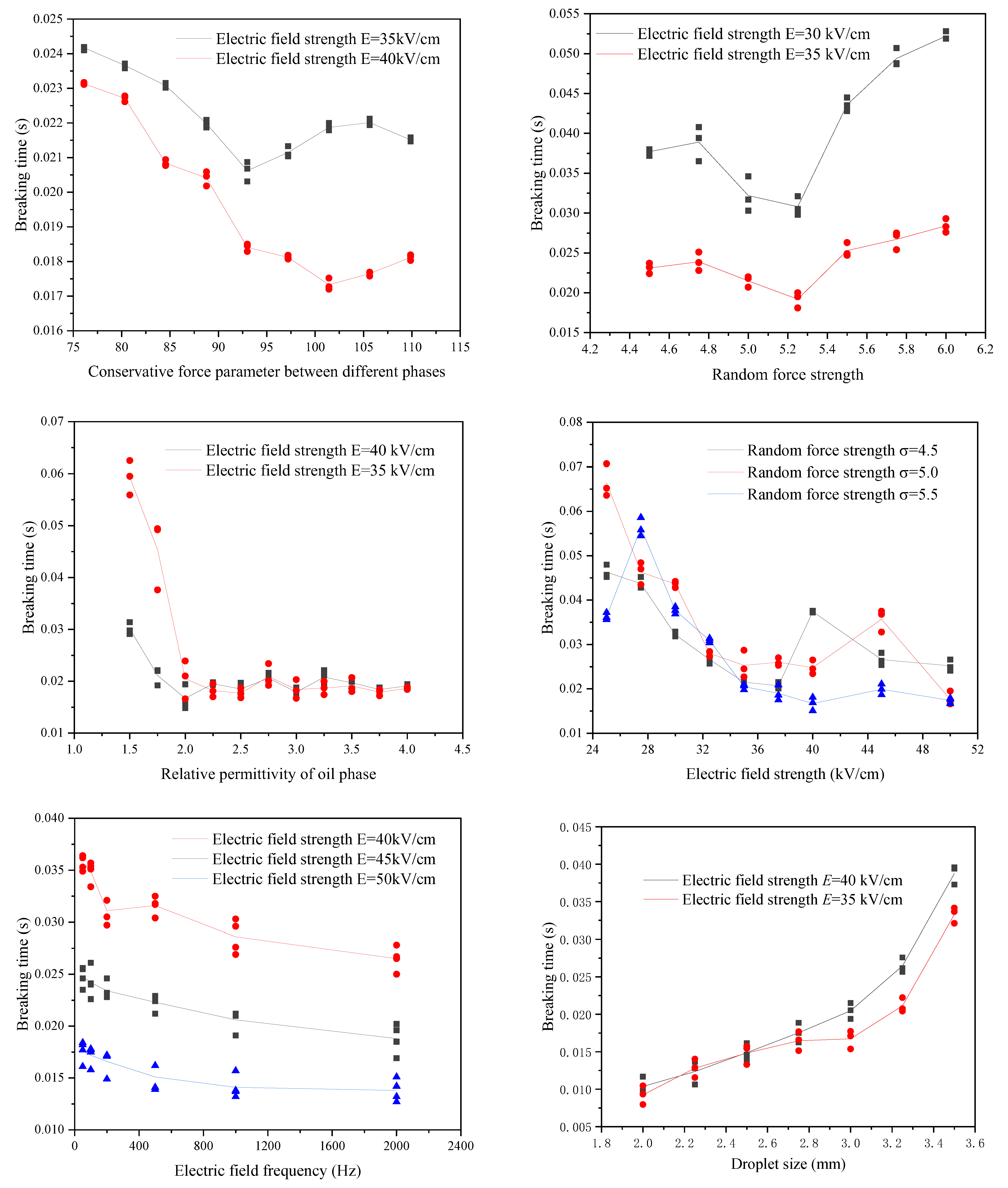

| Phase | Parameters | Symbol | Units | Value |
|---|---|---|---|---|
| Oil | The relative permittivity | εr2 | 1.50, 1.75, 2.00, 2.25, 2.50, 2.75, 3.00, 3.25, 3.50, 3.75, 4.00 | |
| Density | ρ | kg/m3 | 0.84 | |
| Conservative strength | aii | 25.00 | ||
| Random force strength | σ | 4.50, 4.75, 5.00, 5.25, 5.50, 5.75, 6.00 | ||
| Water | The relative permittivity | εr2 | 78 | |
| Density | ρ | kg/m3 | 0.98 | |
| Conservative strength | ajj | 25.00 | ||
| Random force strength | σ | 4.50, 4.75, 5.00, 5.25, 5.50, 5.75, 6.00 | ||
| Oil-Water | Conservative strength | aij | 76.12, 80.34, 84.56, 88.78, 92.99, 97.21, 101.43, 105.65, 109.87 | |
| Electric field | Electric field type | Sinusoidal alternating current, | ||
| Amplitude of electric field intensity | E0 | kV/cm | 25.0, 27.5, 30.0, 32.5, 35.0, 37.5, 40.0, 45.0, 50.0 | |
| Electric field frequency | f | hz | 50, 100, 200, 500, 1000, 2000 | |
| Droplet | Droplet size | r | mm | 2.00, 2.25, 2.50, 2.75, 3.00, 3.25, 3.50 |
Disclaimer/Publisher’s Note: The statements, opinions and data contained in all publications are solely those of the individual author(s) and contributor(s) and not of MDPI and/or the editor(s). MDPI and/or the editor(s) disclaim responsibility for any injury to people or property resulting from any ideas, methods, instructions or products referred to in the content. |
© 2024 by the authors. Licensee MDPI, Basel, Switzerland. This article is an open access article distributed under the terms and conditions of the Creative Commons Attribution (CC BY) license (https://creativecommons.org/licenses/by/4.0/).
Share and Cite
Geng, Y.; Lv, C.; Yuan, X.; Xu, W. Analysis of Electric Breakup Characteristics of Emulsion Droplets Based on Dissipative Particle Dynamics Method. Processes 2024, 12, 1467. https://doi.org/10.3390/pr12071467
Geng Y, Lv C, Yuan X, Xu W. Analysis of Electric Breakup Characteristics of Emulsion Droplets Based on Dissipative Particle Dynamics Method. Processes. 2024; 12(7):1467. https://doi.org/10.3390/pr12071467
Chicago/Turabian StyleGeng, Yiyang, Changhai Lv, Xin Yuan, and Weiwei Xu. 2024. "Analysis of Electric Breakup Characteristics of Emulsion Droplets Based on Dissipative Particle Dynamics Method" Processes 12, no. 7: 1467. https://doi.org/10.3390/pr12071467




